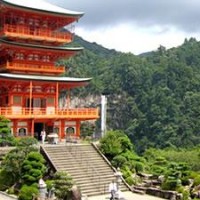Blog
Kumano Kodo pilgrimage in the Empire of the Rising Sun
Fairway is the forum for pilgrimages. This phenomenon has the quality of universalism: it happens in any human community, wherever it is established, anywhere on the planet. Today we talk about the way Kumano Kodo, the most important pilgrimage route from Japan. We choose this path because it represents the human spirit like no touring a way to order thoughts and spirit. A road in the Far East that has its counterpart in the far West, such as Santiago and Finisterre.
The first tests of Kumano Kodo pilgrimage to date from the tenth century. Nihonshoki, the second oldest document preserved in Japan that the emperor Uda went on pilgrimage to the monastery in the region of Kii, where lived the original gods of Japan. The emperor came from Kyoto at 907 but tradition collects evidence that this area was known and revered for some time.
The goal of the journey is the temple Kumano Nachi Taisha. This building is the third goal you know the route, although the area where you have to get is always the same and runs the high mountains of the Kii peninsula, which lies south of Kyoto and Osaka. The first building Kumano Hongu Taisha was built on a small island that was in the Kumano River in the time of Emperor Suijin, in the first century AD., And continued there until there was a flood in 1889. Thus, moved most of the temple city of Hongu where he is today.
Then it is said that the Hayatama Kumano Taisha Shinto temple was built in the time of Emperor Keiko, between the first and second centuries AD of our era.
The emperors came to worship this temple in the most elegant way was known: rich mounted on boats going up the river course and offered his respects to the Shinto deities. Shinto was the predominant religion in Japan until the practice of Buddhism from India through China around the sixth century spread. The teachings of Siddhartha Gautama caused a furor around Japan, especially the idea of reincarnation and life without ambition. The emperors began to support him, and resolved the coexistence of two different beliefs, putting together Shinto Buddhism as if the Buddha was a god more. The temple now welcomes the pilgrims is to be opened following the Buddhist tradition.
So Buddhism and Shinto began to live in the Kii Peninsula as in most of Japan. Today these two religions coexist yet, despite the "Prohibition of merging Shinto with Buddhism" 1868 Act.
The emperors began to go on pilgrimage from Kyoto, the capital at that time, to the peninsula. An emperor came to do it 34 times in his life. So it became fashionable to Kumano Kodo pilgrimage. This custom lasted until the Edo period. After the pilgrimage began to decline during the Meiji era for the sake of the above law. However, in the last two decades it became very popular to make the pilgrimage to this area, perhaps for promotions that have made the authorities of the three prefectures of the peninsula; Wakayama, Nara and Mie.
We appreciate the information from Casa Galicia Japan, collaborator of Fairway.
